tire size CHEVROLET CAMARO 1998 4.G Owners Manual
[x] Cancel search | Manufacturer: CHEVROLET, Model Year: 1998, Model line: CAMARO, Model: CHEVROLET CAMARO 1998 4.GPages: 402, PDF Size: 21.2 MB
Page 4 of 402
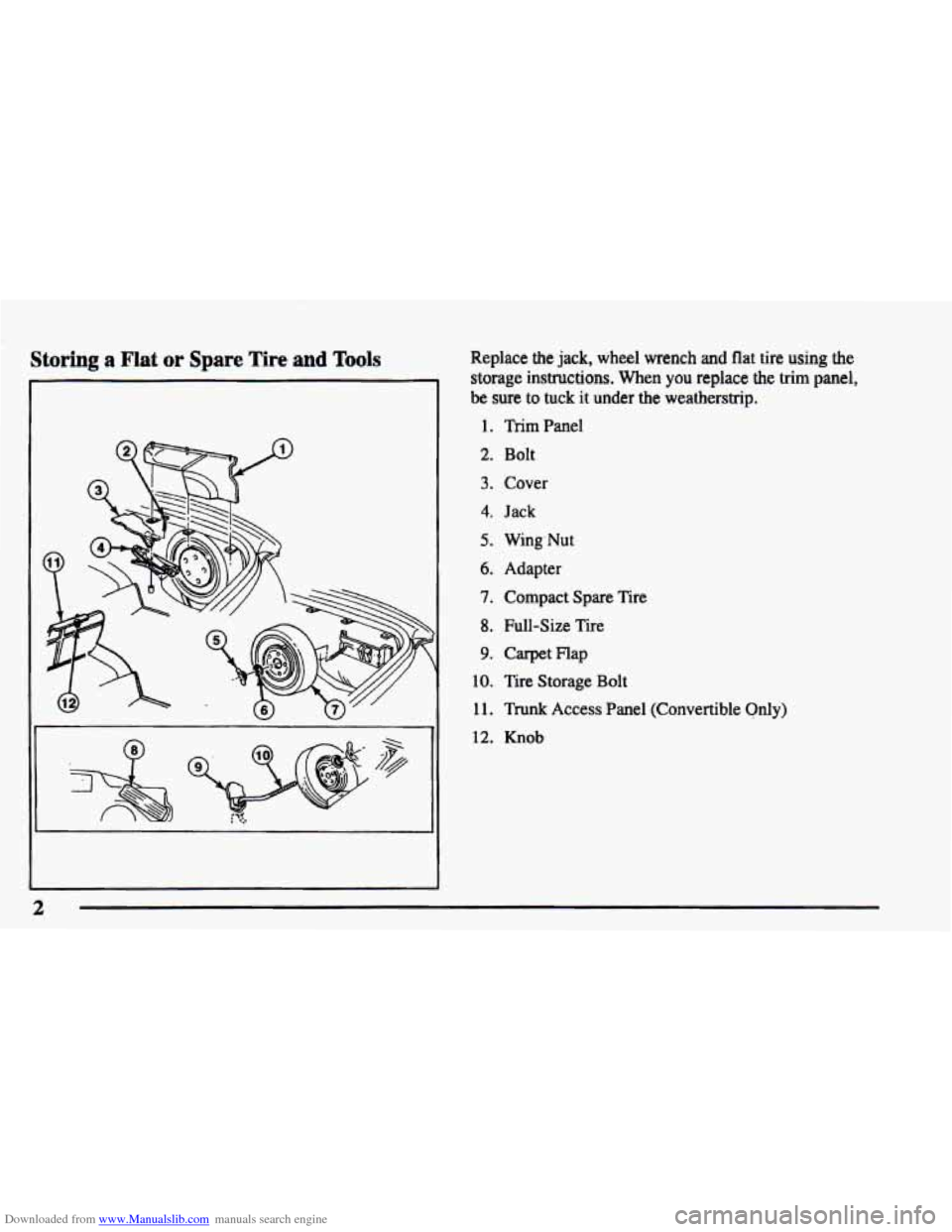
Downloaded from www.Manualslib.com manuals search engine Storing a Flat or Spare Tire and Tools Replace the jack, wheel wrench and flat tire using the
storage instructions. When you replace the trim panel,
be sure to tuck it under the weatherstrip.
1.
2.
3.
4.
5.
6.
7.
8.
9.
10.
11.
12.
Trim Panel Bolt
Cover
Jack
Wing, Nut
Adapter
Compact Spare Tire
Full-Size Tire Carpet Flap
Tire Storage Bolt
Trunk Access Panel (Convertible Only)
Knob
2
Page 208 of 402
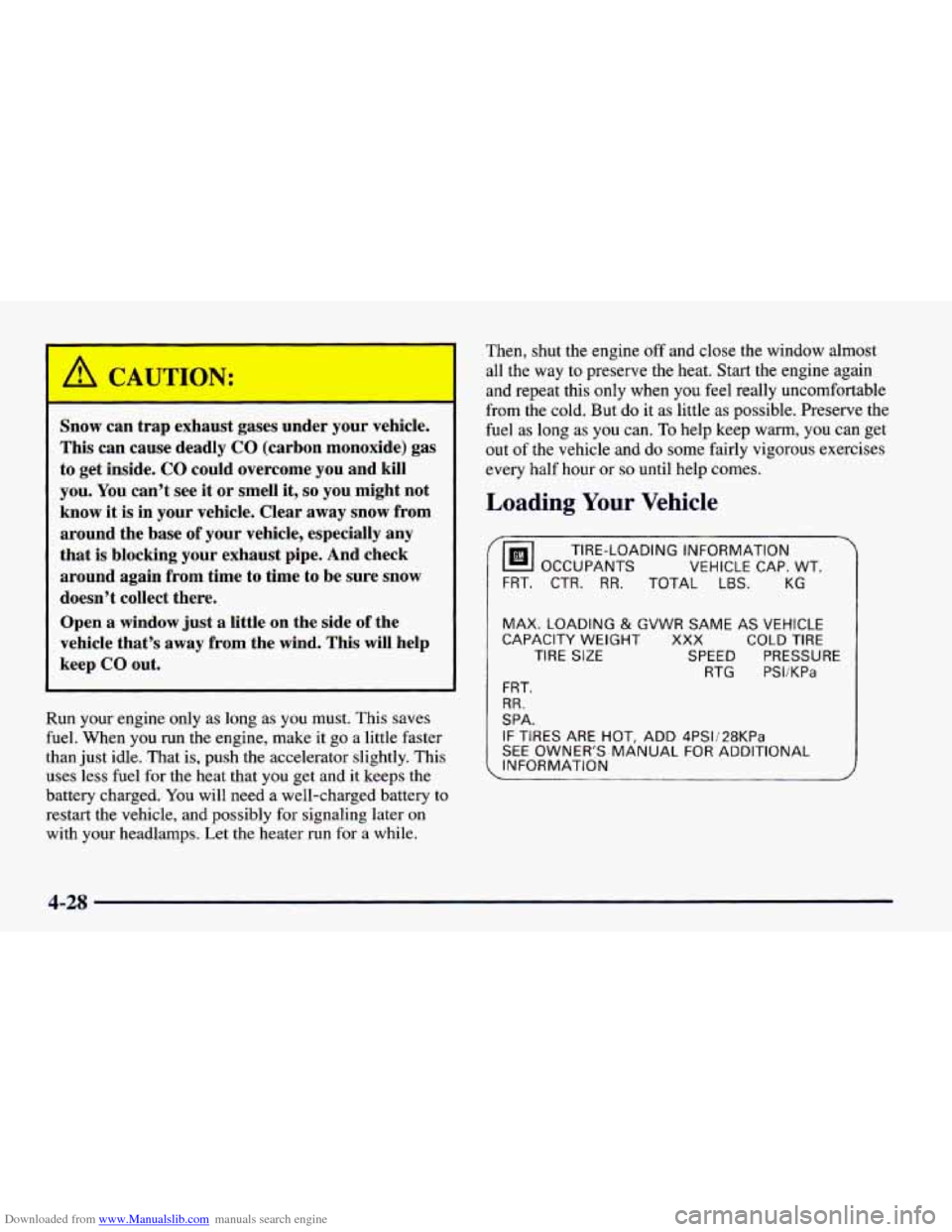
Downloaded from www.Manualslib.com manuals search engine a CAUTION:
Snow can trap exhaust gases under your vehicle.
This can cause deadly
CO (carbon monoxide) gas
to get inside. CO could overcome you and kill
you.
You can’t see it or smell it, so you might not
know it is in your vehicle. Clear away snow from
around the base of your vehicle, especially any
that
is blocking your exhaust pipe. And check
around again from time
to time to be sure snow
doesn’t collect there.
Open
a window just a little on the side of the
vehicle that’s away from the wind. This will help
keep
CO out.
Run your engine only as long as you must. This saves
fuel. When you run the engine, make it go a little faster
than just idle. That is, push the accelerator slightly. This
uses less fuel for the heat that
you get and it keeps the
battery charged.
You will need a well-charged battery to
restart the vehicle, and possibly for signaling later on
with your headlamps. Let the heater run for a while. Then,
shut the engine
off and close the window almost
all the way to preserve the heat. Start the engine again
and repeat this
only when you feel really uncomfortable
from the cold. But do it as little as possible. Preserve the
fuel as long as you can.
To help keep warm, you can get
out of the vehicle and do some fairly vigorous exercises
every half hour or
so until help comes.
Loading Your Ve’ kle
OCCUPANTS
VEHICLE CAP. WT.
.
TIRE-LOADING INFORMATION
FRT, CTR. RR. TOTAL LBS. KG
MAX. LOADING & GVWR SAME AS VEHICLE
CAPACITY WEIGHT XXX COLD TIRE
TIRE
SIZE SPEED PRESSURE
RTG PSPKPa
FRT.
RR.
SPA.
IF TIRES ARE HOT, ADD 4PSli28KPa
SEE OWNER’S MANUAL FOR ADDITIONAL
INFORMATION
4-28
Page 209 of 402
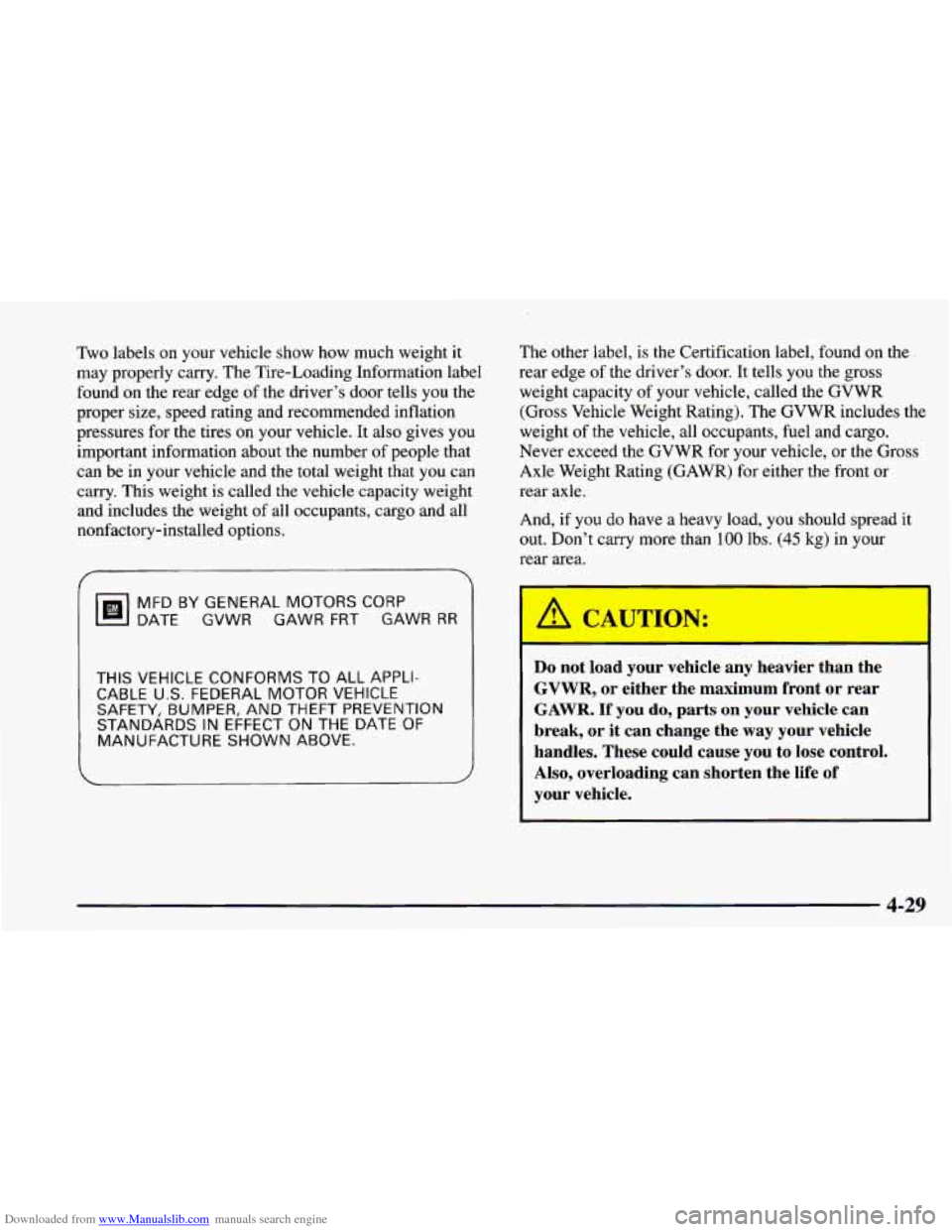
Downloaded from www.Manualslib.com manuals search engine Two labels on your vehicle show how much weight it
may properly carry. The Tire-Loading Information label
found on the rear edge
of the driver’s door tells you the
proper size, speed rating and recommended inflation
pressures for the tires on your vehicle. It also gives you
important information about the number of people that
can be in your vehicle and the total weight that you can
carry. This weight is called the vehicle capacity weight
and includes the weight
of all occupants, cargo and all
nonfactory-installed options.
MFD BY GENERAL MOTORS CORP
DATE GVWR GAWR FRT GAWR ~d
THIS VEHICLE CONFORMS TO ALL APPLI-
CABLE
U.S. FEDERAL MOTOR VEHICLE
SAFETY, BUMPER, AND THEFT PREVENTION
STANDARDS IN EFFECT ON THE DATE OF
MANUFACTURE SHOWN ABOVE.
The other label, is the Certification label, found on the
rear edge
of the driver’s door. It tells you the gross
weight capacity of your vehicle, called the GVWR
(Gross Vehicle Weight Rating).
The GVWR includes the
weight
of the vehicle, all occupants, fuel and cargo.
Never exceed the GVWR for your vehicle, or the Gross
Axle Weight Rating
(GAWR) for either the front or
rear axle.
And, if
you do have a heavy load, you should spread it
out. Don’t carry more than
100 lbs. (45 kg) in your
rear area.
I
Do not load your vehicle any heavier than the
GVWR, or either the maximum front or rear
GAWR. If you do, parts on your vehicle can
break, or it can change the way your vehicle
handles. These could cause you to lose control.
Also, overloading can shorten the life
of
your vehicle.
4-29
Page 255 of 402
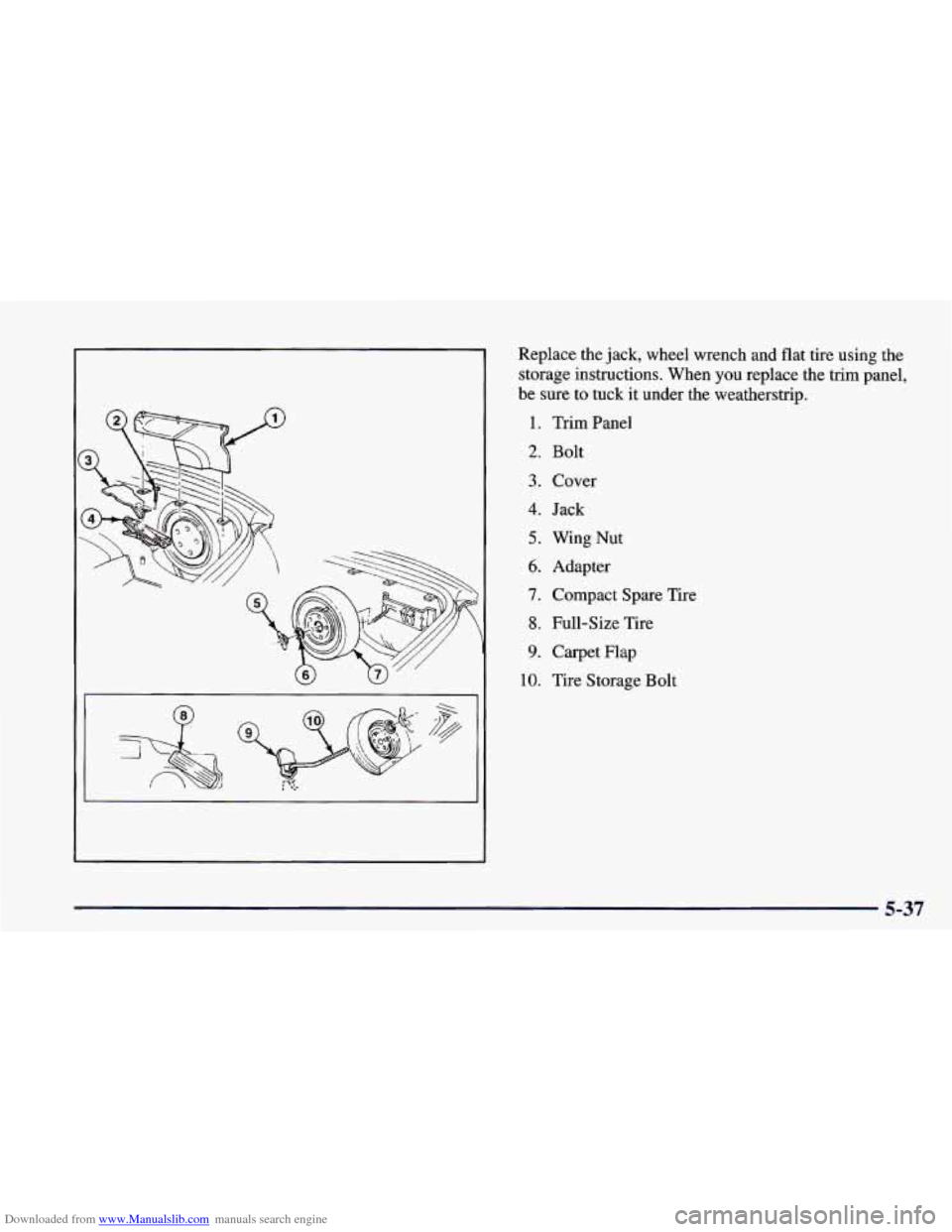
Downloaded from www.Manualslib.com manuals search engine Replace the jack, wheel wrench and flat tire using the
storage instructions. When you replace the trim panel,
be
sure to tuck it under the weatherstrip.
1.
2.
3.
4.
5.
6.
7.
8.
9.
10.
Trim Panel
Bolt
Cover
Jack
Wing Nut Adapter
Compact Spare Tire
Full-Size Tire
Carpet Flap
Tire Storage Bolt
Page 256 of 402
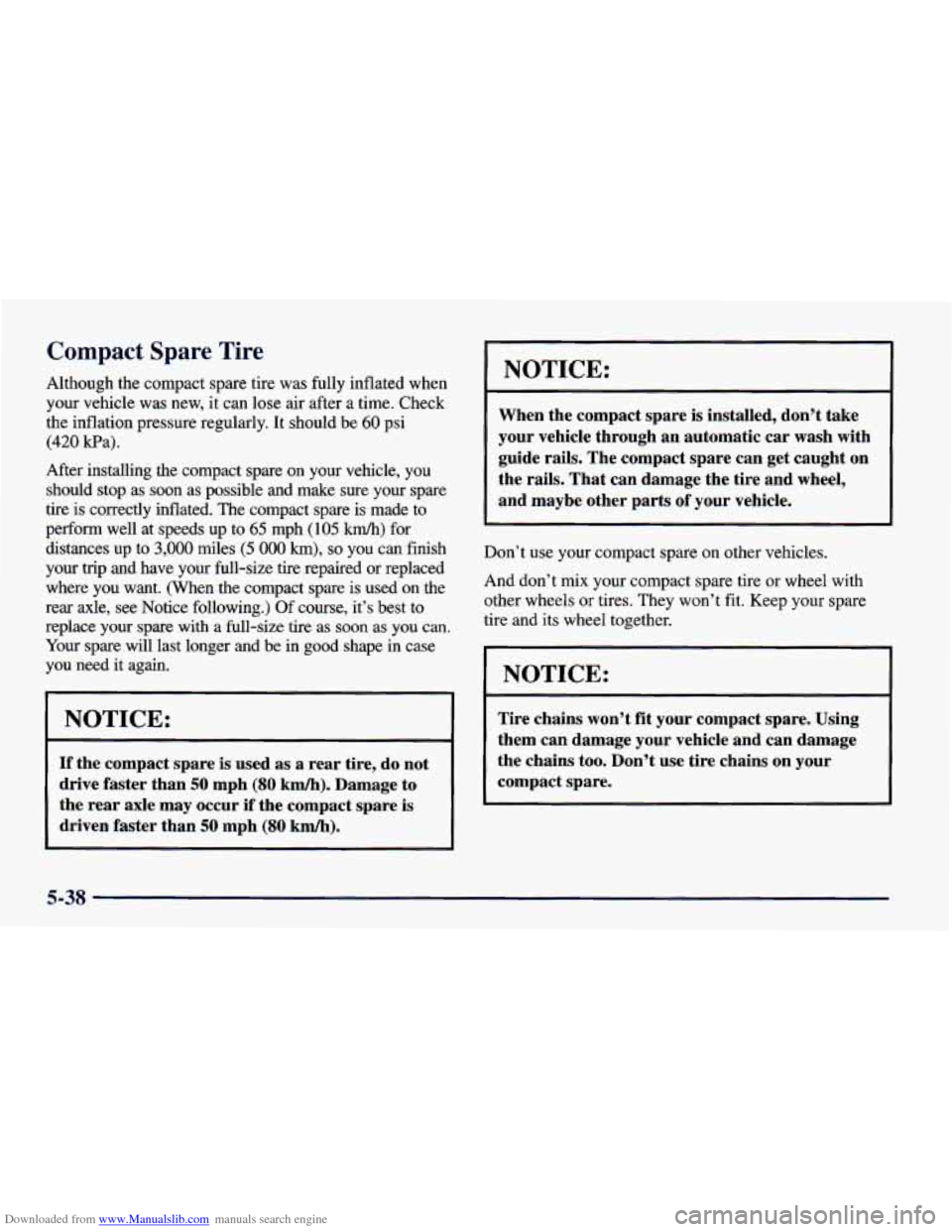
Downloaded from www.Manualslib.com manuals search engine Compact Spare Tire
Although the compact spare tire was fully inflated when
your vehicle was new,
it can lose air after a time. Check
the inflation pressure regularly. It should be
60 psi
(420 Wa).
After installing the compact spare on your vehicle, you
should stop as
soon as possible and make sure your spare
tire is correctly inflated. The compact spare is made to
perform well at speeds up to
65 mph (105 km/h) for
distances up to
3,000 miles (5 OOO km), so you can finish
your trip and have your full-size tire repaired or replaced
where you want. (When the compact spare is used on the
rear axle, see Notice following.)
Of course, it’s best to
replace your spare with a full-size tire
as soon as you can.
Your spare will last longer and be in good shape
in case
you need it again.
NOTICE:
If the compact spare is used as a rear tire, do not
drive faster than
50 mph (80 km/h). Damage to
the rear axle may occur
if the compact spare is
driven faster than 50 mph (80 km/h).
i
I NOTICE:
When the compact spare is installed, don’t take
your vehicle through an automatic car wash with
guide rails. The compact spare can get caught on
the rails. That can damage the tire and wheel,
and maybe other parts of your vehicle.
Don’t use your compact spare on other vehicles.
And don’t mix your compact spare tire or wheel with
other wheels
or tires. They won’t fit. Keep your spare
tire and its wheel together.
I NOTICE:
Tire chains won’t fit your compact spare. Using
them can damage your vehicle and can damage
the chains too. Don’t use tire chains
on your
compact spare.
5-3s
Page 305 of 402
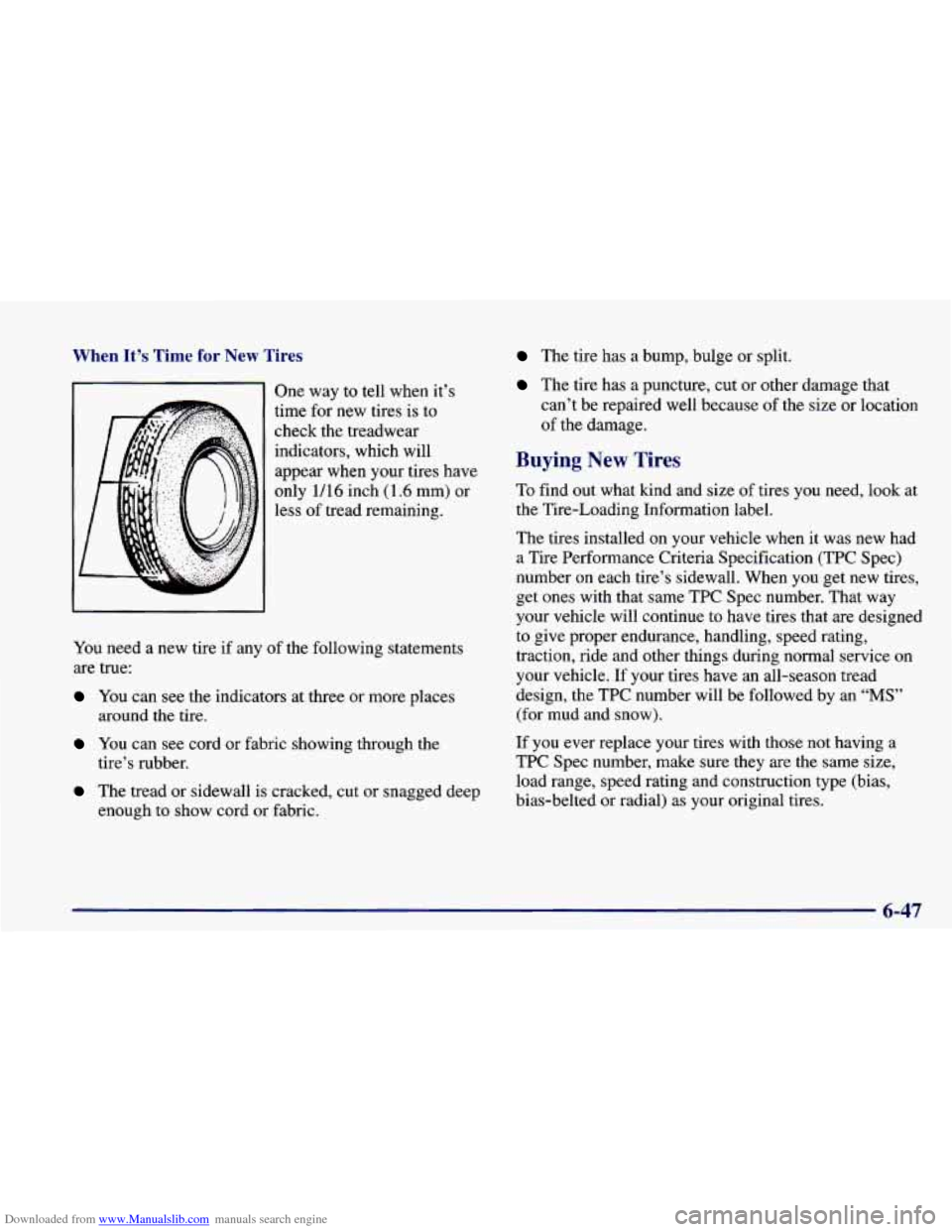
Downloaded from www.Manualslib.com manuals search engine When It’s Time for New Tires
One way to tell when it’s
time for
new tires is to
check the treadwear
indicators, which will
appear when your tires have
only
1/16 inch (1.6 mm) or
less of tread remaining.
You need
a new tire if any of the following statements
are true:
YOU can see the indicators at three or more places
around the tire.
You can see cord or fabric showing through the
tire’s rubber.
The tread or sidewall is cracked, cut or snagged deep
enough
to show cord or fabric.
The tire has a bump, bulge or split.
The tire has a puncture, cut or other damage that
can’t be repaired well because of the size or location
of the damage.
Buying New Tires
To find out what kind and size of tires you need, look at
the Tire-Loading Information label.
The tires installed on your vehicle when it was new had
a Tire Performance Criteria Specification (TPC Spec)
number on each tire’s sidewall. When you get new tires,
get ones with that same TPC Spec number. That way
your vehicle will continue to have tires that are designed
to give proper endurance, handling, speed rating, traction, ride and other things during normal service on
your vehicle.
If your tires have an all-season tread
design, the TPC number will be followed by an
“MS”
(for mud and snow).
If you ever replace your tires with those not having a
TPC Spec number, make sure they are the same size,
load range, speed rating and construction type (bias,
bias-belted or radial) as your original tires.
6-47
Page 306 of 402
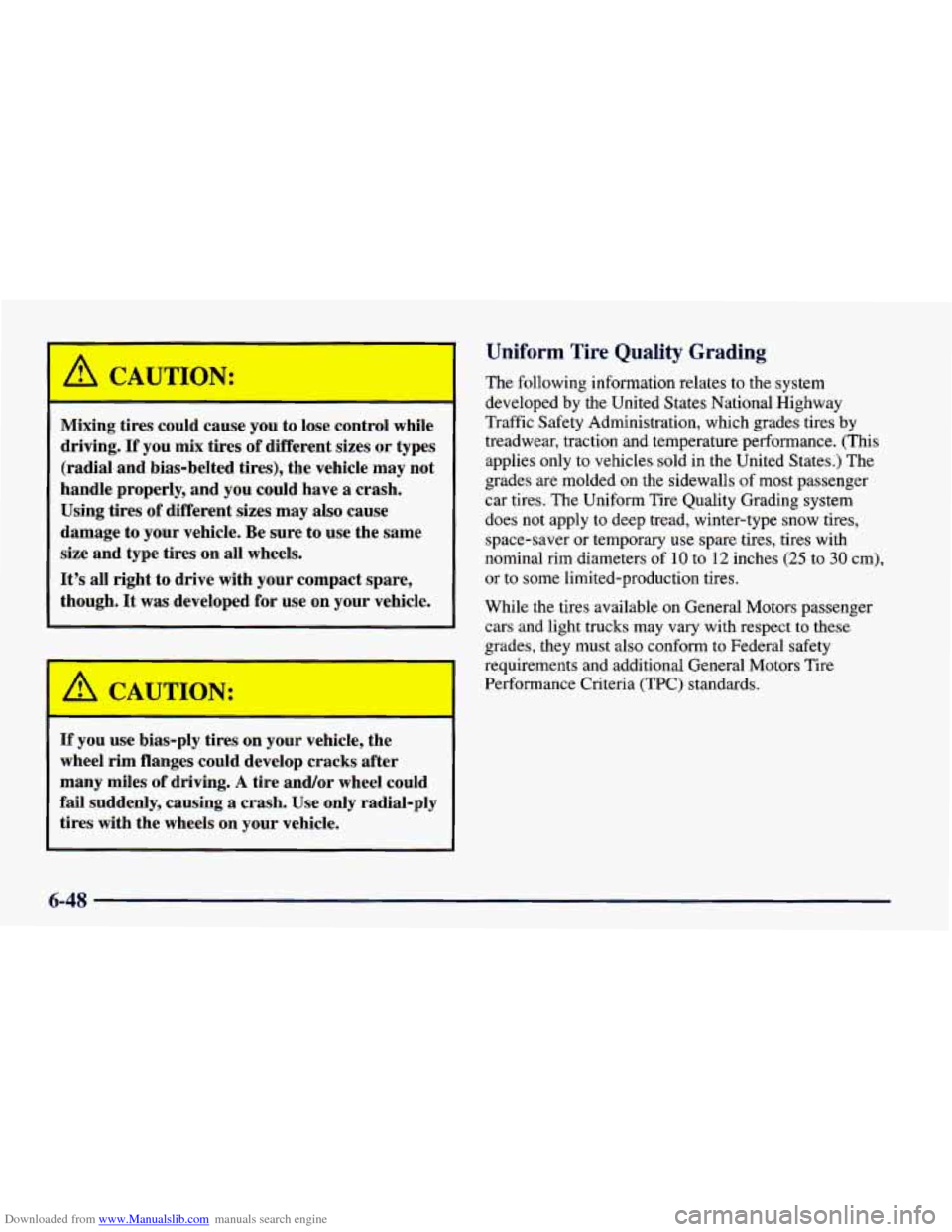
Downloaded from www.Manualslib.com manuals search engine Mixing tires could cause you to lose control while
driving.
If you mix tires of different sizes or types
(radial and bias-belted tires), the vehicle may not
handle properly, and you could have a crash.
Using tires of different sizes may also cause
damage to your vehicle. Be sure
to use the same
size and type tires
on all wheels.
It's all right to drive with your compact spare,
though.
It was developed for use on your vehicle.
If you use bic 'ply tires on your vehicle, the
wheel rim flanges could develop cracks after
many miles
of driving. A tire and/or wheel could
fail suddenly, causing
a crash. Use only radial-ply
tires with the wheels
on your vehicle.
Uniform '--I Quality Grading
The following information relates to the system
developed
by the United States National Highway
Traffic Safety Administration, which grades tires
by
treadwear, traction and temperature performance. (This
applies only to vehicles sold in the United States.) The
grades are molded on the sidewalls
of most passenger
car tires. The Uniform Tire Quality Grading system
does not apply to deep tread, winter-type snow tires,
space-saver or temporary use spare tires, tires with
nominal rim diameters of
10 to 12 inches (25 to 30 cm),
or to some limited-production tires.
While the tires available on General Motors passenger
cars and light trucks
may vary with respect to these
grades, they must also conform to Federal safety
requirements and additional General Motors Tire
Performance Criteria (TPC) standards.
6-48
Page 309 of 402
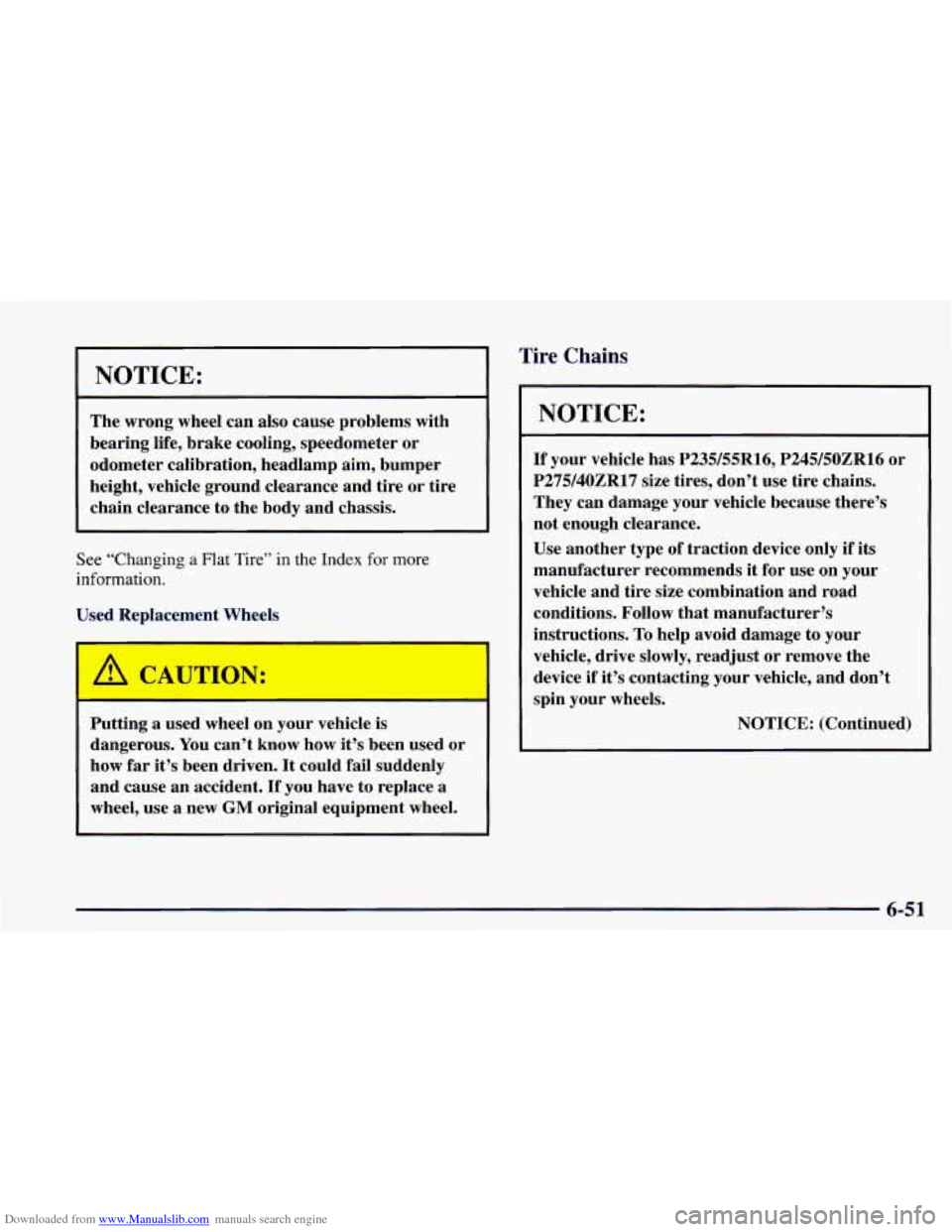
Downloaded from www.Manualslib.com manuals search engine I NOTICE:
~
The wrong wheel can also cause problems with
bearing life, brake cooling, speedometer or
odometer calibration, headlamp aim, bumper
height, vehicle ground clearance and tire or tire
chain clearance to the body and chassis.
See “Changing a Flat Tire” in the Index for more
information.
Putting a used wheel on your vehicle is
dangerous. You can’t know how it’s been used or
how far it’s been driven. It could fail suddenly
and cause an accident.
If you have to replace a
wheel, use a new
GM original equipment wheel.
rire Chains
NOTICE:
If your vehicle has P235/55R16, P245/50ZR16 or
P275/40ZR17 size tires, don’t use tire chains.
They can damage your vehicle because there’s
not enough clearance.
Use another type of traction device only
if its
manufacturer recommends it for use on your
vehicle and tire size combination and road
conditions. Follow that manufacturer’s
instructions.
To help avoid damage to your
vehicle, drive slowly, readjust or remove the
device if it’s contacting your vehicle, and don’t
spin your wheels.
NOTICE: (Continued)
6-51
Page 310 of 402
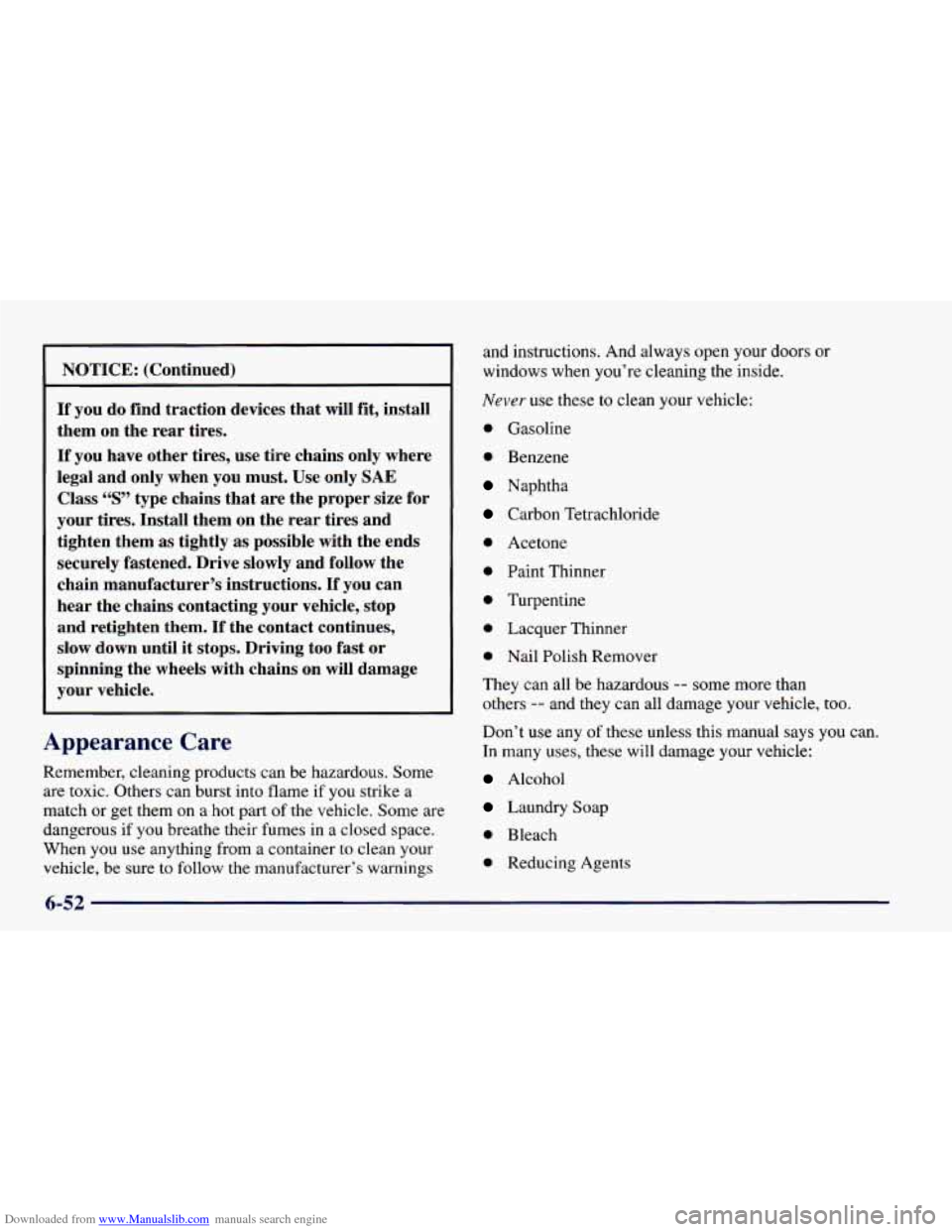
Downloaded from www.Manualslib.com manuals search engine NOTICE: (Continued)
If you do find traction devices that will fit, install
them on the rear tires.
If you have other tires, use tire chains only where
legal and only when you must. Use only
SAE
Class “S” type chains that are the proper size for
your tires. Install them on the rear tires and
tighten them as tightly as possible with the ends
securely fastened. Drive slowly and follow the
chain manufacturer’s instructions.
If you can
hear the chains contacting your vehicle, stop
and retighten them.
If the contact continues,
slow down until it stops. Driving too fast or
spinning the wheels with chains on will damage
your vehicle.
Appearance Care
Remember, cleaning products can be hazardous. Some
are toxic. Others can burst into flame if
you strike a
match or get them on a hot part
of the vehicle. Some are
dangerous
if you breathe their fumes in a closed space.
When
you use anything from a container to clean your
vehicle, be sure
to follow the manufacturer’s warnings and instructions. And always open your doors or
windows when you’re cleaning the inside.
Never use these to clean your vehicle:
0 Gasoline
0 Benzene
Naphtha
Carbon Tetrachloride
0 Acetone
0 Paint Thinner
0 Turpentine
0 Lacquer Thinner
0 Nail Polish Remover
They can all be hazardous
-- some more than
others
-- and they can all damage your vehicle, too.
Don’t use any of these unless this manual says you can.
In many uses, these will damage your vehicle:
Alcohol
Laundry Soap
0 Bleach
0 Reducing Agents
Page 319 of 402
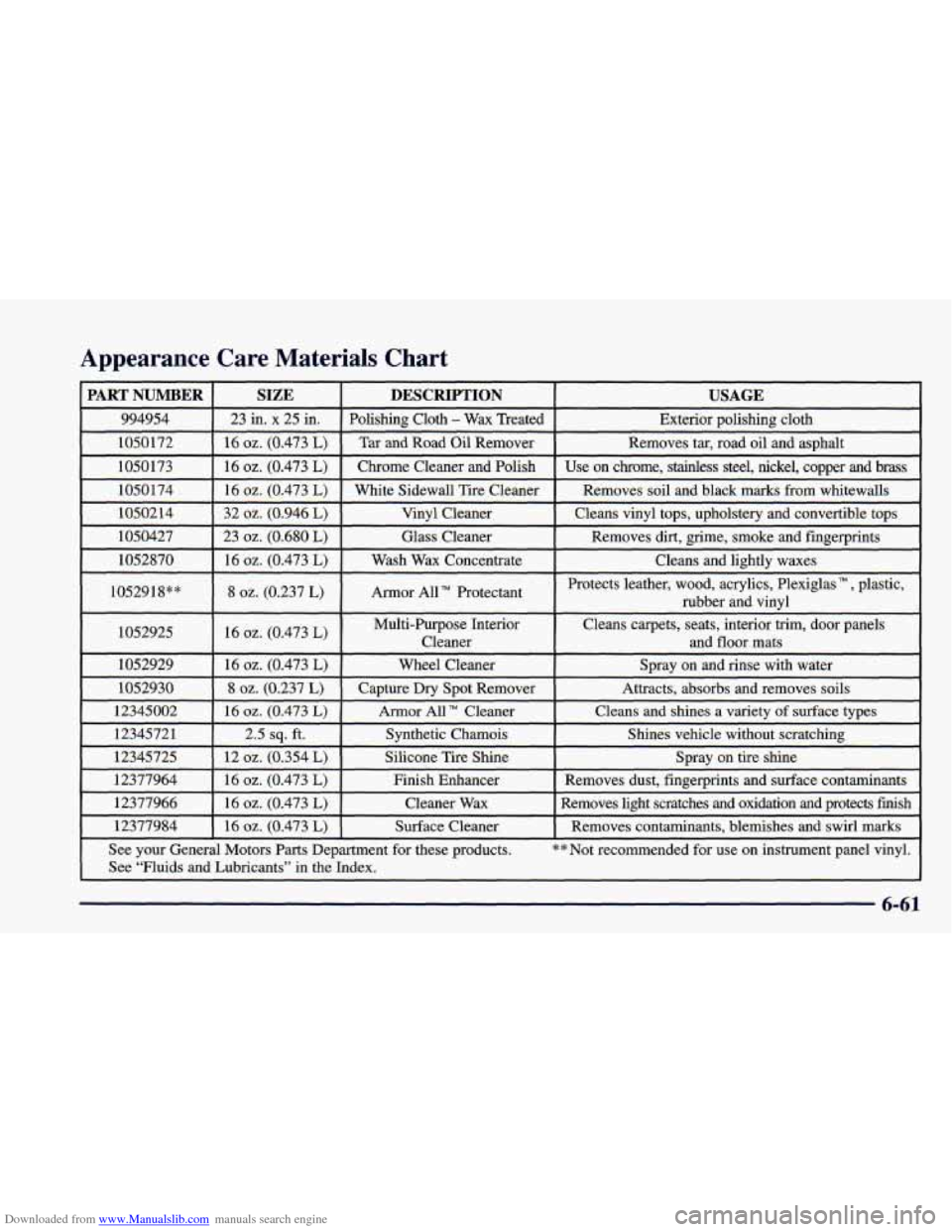
Downloaded from www.Manualslib.com manuals search engine Appearance Care Materials Chart
I 1050172
I 1050173
I 1050174
1052918**
SIZE DESCRIPTION USAGE
23 in. x 25 in. Polishing Cloth - Wax Treated Exterior polishing cloth
1052925
1052929
1052930
12345002
1234572
1
12345725
12377964
12377966
12377984
_____
16 oz. (0.473 L) Tar and Road Oil Remover Removes tar, road oil and asphat
16
oz. (0.473 L) Chrome Cleaner and Polish Use on chrome, stainless steel, nickel, copper and brass
16 oz. (0.473 L) White Sidewall Tire Cleaner Removes soil and black marks from \
whitewalls
32
oz. (0.946 L) Vinyl Cleaner Cleans vinyl tops, uphokeryand convertibletops ~
23 oz. (0.680 L) Glass Cleaner Removes dirt, grime, smoke and fingerprints
16
oz. (0.473 L) Wash Wax Concentrate
~~ _- ~-. ~
Cleans and lightly waxes
8 oz. (0.237 L) Annor All” Protectant I I
Protects leather, wood, acrylics, Plexiglas m, plastic,
rubber and vinyl
16
oz. (0.473 L)
16 oz. (0.473 L) Wheel Cleaner Spray on and rinse with water
Multi-Purpose Interior Cleans carpets, seats, interior trim, door\
panels
Cleaner and floor mats
8 02. (0.237 L) Capture Dry Spot Remover Attracts, absorbs and removes soils
16
oz. (0.473 L) Armor All TM Cleaner Cleans and shines a variety of surface types
2.5
sq. ft. Synthetic Chamois Shines vehicle without scratching
12
oz. (0.354 L) Silicone Tire Shine Spray
on tire shine
16
oz. (0.473 L) Finish Enhancer Removes dust, fingerprints and surface contaminants
16
oz. (0.473 L) Cleaner Wax Removes light scratches and oxidation and protects finish
16
oz. (0.473 L) Surface Cleaner Removes contaminants, blemishes and swirl marks I
See your General Motors Parts Department for these products. **Not recommended for use on instrument panel vinyl.
See “Fluids and Lubricants” in the Index.
-_-
, __.~ - - .- 6-61